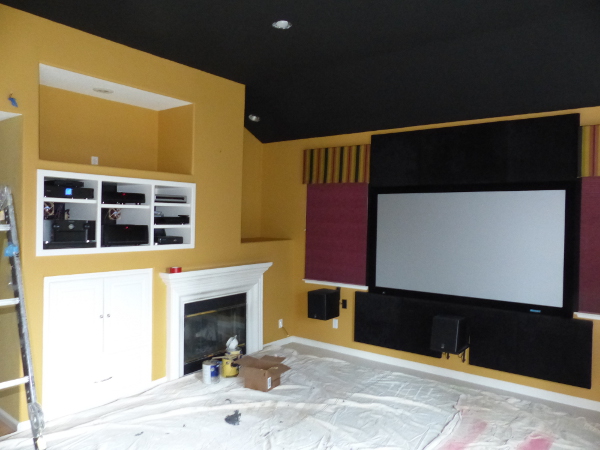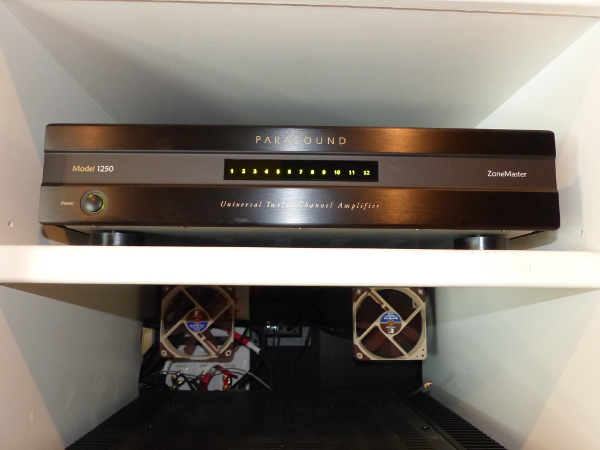Atmos Makeover: A Space Odyssey, Part 2
With the majority of the construction work complete, I turned my attention to putting the room back together, beginning with remounting my projector. With the ceiling now at a much lower 10-foot, 7-inch height, my old ceiling mount and long suspension pole would hang almost to the floor, so a replacement was in order. Fortunately, I found some great deals on used equipment on eBay. I really wanted a mount that could be moved easily in the event of reviewing a projector that needed a different throw distance than my JVC X500, so I settled on a Chief CMA372 Offset Unistrut adapter along with a CMS0203 2-3-foot extension. This allowed me to mount a three foot section of Unistrut to my ceiling and gave me placement options ranging from 96 inches to as long as 132 inches from my screen. As an added bonus, I was able to move my current projector forward about 6 inches and increased its brightness in the process.
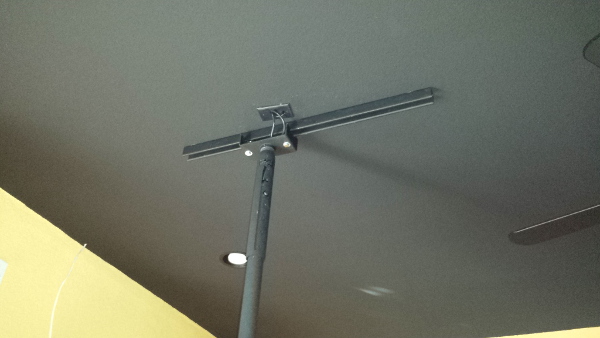
Going through such an extensive construction process also allowed me to fix some of my in-wall wiring challenges with the old room setup. I had previously been using a 15-meter (49.2 feet) Monoprice Redmere HDMI cable with active signal boosting since the line needed to run up to and through my attic to reach the projector. The newly lowered ceiling cut the distance down by nearly half. But with high-bandwidth 4K on the horizon, I was also worried about using another traditional 10-meter (33 feet) HDMI cable—even one with the Redmere technology. So I ran multiple Cat6 cables from my equipment rack into my new attic space and decided to try out an HDBaseT transmission solution. Even putting aside the benefits of HDBaseT or other active balun extenders, anyone who’s ever run HDMI cables in-wall knows it’s a major pain in the neck due to their large connectors—Cat6 is so much easier. I ultimately settled on the Atlona AT-UHD-EX-70-2PS HDBaseT transmitter/receiver kit to handle this duty. It costs about $310 online and can extend a 4K/60Hz HDMI signal up to 130 feet, or 230 feet for 1080p, along with Dolby TrueHD or DTS-HD Master Audio soundtracks. And it’s got the HDCP 2.2 copyright management that’s critical for Ultra HD Blu-ray and streaming services. Installation was a breeze and it works like a charm. While there’s no such thing as future-proof in the electronics world, the Atlona solution does at least give me some peace of mind.
Since I was upgrading to Atmos, a new HDMI solution wasn’t the only new equipment I was going need. Fortunately, Rob asked me to review the new Marantz AV8802 Atmos-enabled flagship surround processor (review coming soon). As an owner of Marantz’s previous flagship, the AV8801, I couldn’t wait to get the updated 8802 installed and hear all that it was capable of. But even with an Atmos-capable prepro, I wasn’t out of the woods yet.
My current amplifiers include a five-channel Parasound Halo A51 for my front three speakers and side surround speakers, along with a Parasound Halo A23 stereo amp for my rear surrounds. Rack space in my custom made cabinet is at a premium and there was no way to include an additional component to power my planned 7.2.4 system. So I would need to replace the A23 with another amplifier delivering a minimum of six channels. To complicate matters, the new unit would have to go on a shelf that couldn’t hold more than 50 pounds. This limited my options severely.
Fortunately, Parasound came to the rescue by releasing its new 12-channel ZoneMaster Model 1250. This is a highly flexible component designed to appeal to custom installers running large multizone audio systems. While I certainly didn’t need 12 channels (at least, not yet), the 1250 gives you the ability to bridge the 12 channels into six, providing 160 watts into 8 ohms or 200 Watts into 4 ohms, and it only weighs 17 pounds. It accomplishes this by using a Class AB input stage plus a premium Class D power stage. I’ve reviewed some Class D amps in the past and have been impressed with them, and I was confident the Model 1250 would fit my needs, particularly for running rear and Atmos surrounds.
My next decision was what to install for the in-ceiling Atmos height speakers. With my main speakers being M&K S150s across the front and four SS150s across the rear, my preference would have been to stick with M&K and keep it all in the family. Unfortunately, the old M&K I bought my speakers from is no longer in business, and although the company has resurfaced under new ownership in Europe, getting product from them would be a time-consuming (not to mention costly) process that I wasn’t willing to go through. So I turned to other options.
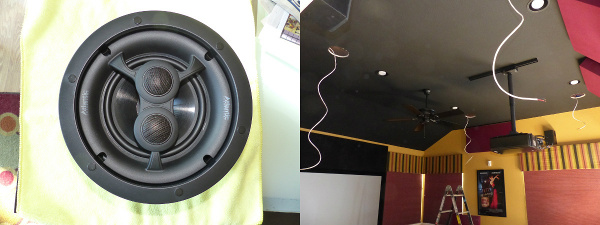
One concern I had about using in-ceiling speakers is hot spotting—the ability to pinpoint exactly where the sound is coming from. To help alleviate this phenomenon, I wanted speakers with a very wide dispersion pattern. This is where Atlantic Technology stepped in with its newly announced IC-6 OBA speaker (above), which was specifically designed for object-based audio systems. It includes a 6-inch woofer coupled with dual 1-inch soft dome tweeters and is designed to eliminate hot spotting and localization. There was only one problem—they hadn’t been released yet. I contacted the Atlantic Technology president Peter Tribeman via email, and he assured me they would be out in late January or early February at the latest. So I went ahead and ordered four speakers.
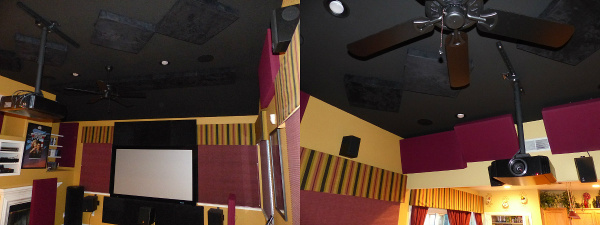
While I awaited the arrival of the new speakers, I went ahead and retreated my room acoustically with the help of Brian Pape at GIK Acoustics. Fortunately I was able to reuse all of my prior room treatments. I did have to reconstruct a couple of four-foot panels to fit my needs along with changing their color schemes by purchasing some acoustically-transparent black fabric. As you can see from the pictures above, the panels definitely integrate well with my décor (a great selling point with my wife) and they help tame the bass response in the room, allowing for a flatter frequency response.
Fortunately my wait for the in-ceiling speakers was only a couple of weeks from the time of construction, and I spent a Saturday morning cutting holes for the speakers, stuffing the ceiling enclosure with Polyfill, and installing them. This process was relatively painless since I’d laid out the room pre-construction and knew exactly where to place each one and there was a wire waiting for me behind the drywall. Once installed, I ran through an Audyssey calibration. It was time to find out if the project was worth all the time and expense.
